Research Abstract
Currently, there is a need for strength-based recreation therapy approaches which promote the retention of skills and abilities of those diagnosed with Alzheimer’s’ disease. These two pilot studies, conducted in 2008, utilized this emerging multi-modal intervention: Therapeutic Thematic Arts Programming for Older Adults (TTAP Method©), an approach which provides stimulation to three distinct brain systems, naturally stimulating person centered programming, encouraging brain wellness and neural regeneration, thereby providing a viable means for enhancing cognitive functioning in those diagnosed with this neurological disorder. Research on TTAP Method© efficacy on those individuals with mild AD at Cornell University is currently being statistically analyzed as this paper is being drafted. Early indications from the Cornell Study indicate that all three pilot studies conducted between 2008-09, strongly indicate that the TTAP Method© may be an effective intervention for slowing the progression of MCI to Alzheimer’s Disease. TTAP Method© is person centered, culturally competent, and employs a variety of recreation/art activities.
Overview
The prevalence of MCI in the general population is reported to be as high as 25% for adults 65 years and older,1,2,3,4,5, and the progression from MCI to AD per year is reported to be approximately 12% to 14%. 6,7 Multimodal interventions (a variety of mixed interventions, stimulating all regions of the brain) have proven to be extremely successful in early stages of mild cognitive impairment (MCI)/Alzheimer’s disease (AD) for decreasing symptoms. 8,9 Such interventions are designed to provide a wide variety of stimuli, positively affecting and increasing neuronal activity, responses, and plasticity.9,10
TTAP Method© is a multimodal, art/ recreation process that employs art/recreation interventions within a nine step structure in order to inhibit the progression of MCI to AD.11 The TTAP Method© maximizes interaction among participants, stimulates all aspects of brain functioning, addresses social and emotional needs, and integrates opportunities for life review.11 The TTAP Method© therefore provides the early intervention needed in order to assist older adults in retaining cognitive and psychosocial abilities. 8,12,13,14
Methodology
Research on the TTAP Method is rapidly increasing. The first investigation on the TTAP Method© took place at Nazareth College of Rochester with the Hispanic population (Alders, 08). This study investigated the role of various activities on cognitive performance in a community sample of Hispanic elderly subjects. The primary aim of the study was to examine whether engagement in structured art/recreation activity, such as TTAP Method(c), was predictive of cognitive performance. The research followed a quasi-experiment, pretest/post test format which allowed investigation of the hypothesis that creative activity accounts for positive changes in cognitive functioning. This hypothesis predicts that dynamic, mentally stimulating activity is essential in protecting against cognitive decline associated with age and is positively correlated with cognitive performance.
General procedure: 24 Subjects were interviewed in a Hispanic community center by bilingual interviewers, allowing for culturally sensitive interaction. Information necessary for the evaluation of cognitive functioning was collected in the form of the neurological clock drawing task (Clock Drawing Test- sensitivities: up to .86; specificity: up to .96). The Clock Drawing Test (CDTs) were blindly and independently scored by three raters, using the clock drawing interpretation/scoring system described by Sunderland et al. Participants were also given a pre and post self-report known as the Cognitive Failures Questionnaire (CFQ), pertaining to the frequency of everyday deficits in attention, perception, memory, and motor coordination (CFQ-internal validity: 0.91; test-retest reliability rate: 0.82). Additionally, personal and demographic information was collected at the onset of the investigation, including education, age, gender, country of origin, date of immigration to U.S., and level of social support. Art therapy sessions were provided weekly. The experiment duration totaled 12 weeks.
Participation in creative activity as a factor of cognitive functioning: The statistical significance of the variables was examined using the program SHAZAM ( P < .05). Dependent variable: Difference in pre/post scores. Independent variable: Number of art therapy sessions attended.
Results:
A total of 8 variables were taken into account. Those variables included: age, country of origin, gender, education level, duration spent in the US, frequency of self-directed art making, living arrangements, and attendance to art therapy sessions.
Only attendance to art therapy sessions was found to have a significant correlation to cognitive evaluation test scores. Correlations among activity and cognitive performance: Cognitive performance scores for both the CFQ and CDT were positively and significantly correlated to participation in art therapy sessions. (The p-values were .010 and .021 respectively).
The second pilot studies were conducted by fourth year students at St. Thomas Aquinas College at Bergen Regional Medical Center, the Alzheimer’s locked Unit.
These two studies investigated the subjective responses to the TTAP Method vs. daily recreation therapy sessions. The primary aim of the study was to examine four overall questions 1) Did individuals feel the TTAP sessions increased their overall feelings of quality of life? 2) Did the sessions positively affect their personal needs? 3) Did the sessions enhance verbalization? 4) Does the TTAP Method naturally increase opportunities for cognitive stimulation in programming?
This research study followed an experimental design. Each TTAP Method session was followed with post session questions from the Farrington Leisure Evaluation Scale (adapted for this research study). This format allowed investigation of the hypothesis that those individuals with moderate AD could evaluate and give feedback regarding their likes and dislikes of the multimodal art/recreation activity. This hypothesis predicts that dynamic, mentally stimulating multimodal approach is essential at any stage of the disease process and can have an overall affect on psychosocial wellbeing, increased verbalization and enhance cognitive stimulation.
General Procedure conducted for Bergen Regional Medical Center: 4 students were assigned to
6 residents (consent forms were administered through legal guardians with IRB approval) diagnosed with moderate levels of Alzheimer ’s disease. For seven weeks students meet with the same 6 individuals, and designed a different multimodal TTAP Method session each week for 1 ½ hours. At the end of each session students utilized a modified version of Farmington’s Leisure Evaluation Scale (using 1-5 Lickert Scale) and open ended questions, to attain responses from the participants regarding “their voice” in the overall evaluation of each session. The results were tabulated by the students as part of the Research Methods Course in Therapeutic Recreation at St. Thomas Aquinas College, using SPSS software for data analysis.
Results:
Question 1: Findings demonstrated high levels of self satisfaction throughout the 7 sessions rating at 4.85 out of 5. Question 2: The TTAP Method was shown to had a direct effect on rresodents feelings of needs being met with a 4.9 rating. Question 3: The TTAP Method was shown to increase verbal interactions through both by the students’ subjective observations and open ended questions that the residents answered. Question 4: The TTAP Method was found to increases multiple opportunities for stimulation cognition through student observations and residents open end responses which will be discussed in detail.
Implications:
The TTAP Method© is an innovative and viable multimodal recreation/art therapy method for slowing the progression of AD. It is rapidly being incorporated into various research projects in New Zealand, Finland, Australia and the United States due to the fact that it lends itself to systematization while at the same time providing person centered individualized care. The TTAP Method© was developed out of current growing neuroscience research which demonstrates that the life experiences and activities that challenge the mind in a safe and socially validating person centered way result in positive and continuous changes in the human brain, even in the individual with Mild AD, Moderate AD or advanced stages. Therapeutic Thematic Arts Programming – the TTAP Method© incorporates activities that have shown to be emotionally meaningful which has been researched to demonstrated that our cognitive abilities to recall are enhanced if accompanied by a positive emotional event15, Therapeutically stimulating activities directly enhancing the neuroplasticity of the brain, specifically in the hippocampus region. The TTAP Method© engages participants in a group or individual art/ recreation therapy format which ensures a higher likelihood of full participation from each participant by providing nine steps that accommodate all known information processing styles. Most significant to the therapist serving this ever growing special population is that a wide variety of data sources demonstrate that the recreation/ arts have a positive impact on quality of life. Factors associated with quality of life include but are not limited to; self expression, self-worth, increased socialization, feelings of belonging to something greater, ability to self challenge themselves, and meaningful quality time. 16,17
It is my hope that by October, I will be able to additionally add to the discussion the results of the Cornell University and Weil Medical Center outcomes of 8 participants living in the community diagnosed with early onset AD.
References
1. Gurland, B., Wilder, D., Lantigua, R., Stern, Y. & Chen, J. (1999). Rates of dementia in three ethno-racial groups. International Journal of Geriatric Psychiatry, 14(6), 481– 493.
2. National Institute on Aging, Progress Report on Alzheimer’s disease. (2005). NIH Publication No. 05-5724. Bethesda, MD: Author. Retrieved from http://www.alzheimers.org/pr04-05/index.asp
3 Kumara, R., Dearb, K., Christensenb, H., Ilschnerb, S., Meslinb, S. & Sachdevc, P. (2005). Prevalence of Mild Cognitive Impairment in 60- to 64-Year-Old Community-Dwelling Individuals: The Personality and Total Health through Life 60+ Study. Dementia and Geriatric Cognitive Disorders, 19, 67-74.
4. Manly, J., Tang, M., Schupf, N. & Stern., Y. (2005). Implementing diagnostic criteria and estimating frequency of mild cognitive impairment in an urban community. Archives of Neurology, 62, 1739-1746.
5. Pressley, J., Trott, C. & Tang, M. (2003). Dementia in community-dwelling elderly patients: a comparison of survey data, medicare claims, cognitive screening, reported symptoms, and activity limitations. Journal of Clinical Epidemiology, 56, 896-905.
6. Davie, J., Azuma, T., Goldinger, S., Connor, D., Sabbagh, M. and Silverberg, N. (2004). Sensitivity to expectancy violations in health aging and mild cognitive impairment. Neuropsychology, 18(2), 269-275.
7. Fernandez-Ballesteros, R., Zamarron, M.D., Tarraga, L., Moya, R. & Iniguez, J. (2003). Cognitive plasticity in healthy, mild cognitive impairment (MCI) subjects and Alzheimer’s disease patients: A research project in Spain. European Psychologist, 8(3), 148-159.
8. Rentz, C. (2002). Memories in the Making©: Outcome-based evaluation of an art
based program for individuals with dementing illnesses. American Journal of Alzheimer’s Disease and other Dementias, 17(3), 175-181.
9. Chertkow, H., Verret, L. & Bergmen, H. (2001). Predicting progression to dementia in elderly subjects with Mild Cognitive Impairment: A multidisciplinary approach. Contemporary Clinical Issues. Plenary Session, 53rd Annual Meeting of the American Academy of Neurology. Philadelphia.
10. Burgener, S., Gilbert, R. & Mathy, R. (2007). The effects of a multi-modal intervention on cognitive, physical, and affective outcomes of persons with early stage dementia. Journal of Alzheimer’s Disease and Related Disorders, 12, 143-156.
11. Madori, L. (2007). Therapeutic Thematic Arts Programming for Older Adults.
Baltimore, MD: Health Professions Press.
12. Hass-Cohen, N. & Carr, R. (Eds.). (2008). Art therapy and clinical neuroscience. London: Jessica Kingsley.
13. Moniz-Cook, E., Agar, S., Gibson,G., Win, T. & Wing, M. (1998). A preliminary study of the effects of early intervention with people with dementia and their families in a memory clinic. Aging& Mental Health, 2(3), 199-211.
14. Kluger, A., Ferris, S., Golomb, J., Mittelman, M. & Reisberg, B. (1999). Neuropsychological prediction of decline to dementia in nondemented elderly. Journal of Geriatric Psychiatry and Neurology, 12, 168-179.
15. Lyons, W. (1999) ‘The philosophy of cognition and emotion’, in T. Daleish and M.J. Power (eds), Handbook of Cognition and Emotion. Chichester: Wiley.
16. Clare,L. (2002) We’ll fight as long as we can: coping with AD: Aging & Mental Health, 6, 139-148.
17. Lawton M.P. (1994). Quality of life in Alzheimer’s disease. Alzheimer’s Disease and Associated disorders, 8 (suppl.3) 138-150.









